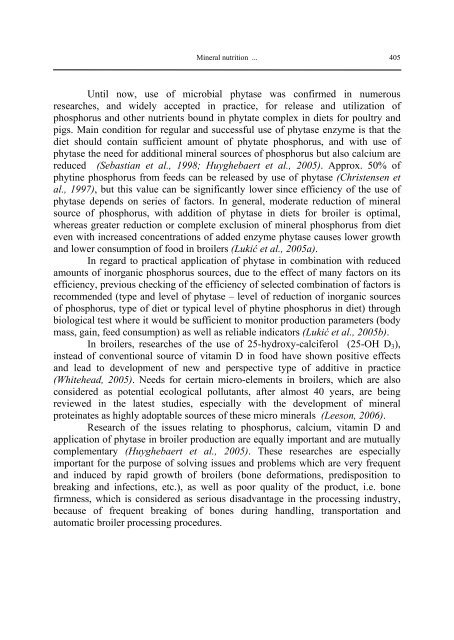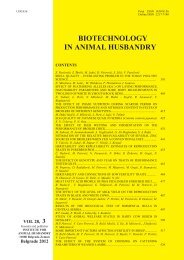MINERAL NUTRITION OF MODERN POULTRY ... - doiSerbia
MINERAL NUTRITION OF MODERN POULTRY ... - doiSerbia
MINERAL NUTRITION OF MODERN POULTRY ... - doiSerbia
Create successful ePaper yourself
Turn your PDF publications into a flip-book with our unique Google optimized e-Paper software.
Mineral nutrition ...<br />
Until now, use of microbial phytase was confirmed in numerous<br />
researches, and widely accepted in practice, for release and utilization of<br />
phosphorus and other nutrients bound in phytate complex in diets for poultry and<br />
pigs. Main condition for regular and successful use of phytase enzyme is that the<br />
diet should contain sufficient amount of phytate phosphorus, and with use of<br />
phytase the need for additional mineral sources of phosphorus but also calcium are<br />
reduced (Sebastian et al., 1998; Huyghebaert et al., 2005). Approx. 50% of<br />
phytine phosphorus from feeds can be released by use of phytase (Christensen et<br />
al., 1997), but this value can be significantly lower since efficiency of the use of<br />
phytase depends on series of factors. In general, moderate reduction of mineral<br />
source of phosphorus, with addition of phytase in diets for broiler is optimal,<br />
whereas greater reduction or complete exclusion of mineral phosphorus from diet<br />
even with increased concentrations of added enzyme phytase causes lower growth<br />
and lower consumption of food in broilers (Lukić et al., 2005a).<br />
In regard to practical application of phytase in combination with reduced<br />
amounts of inorganic phosphorus sources, due to the effect of many factors on its<br />
efficiency, previous checking of the efficiency of selected combination of factors is<br />
recommended (type and level of phytase – level of reduction of inorganic sources<br />
of phosphorus, type of diet or typical level of phytine phosphorus in diet) through<br />
biological test where it would be sufficient to monitor production parameters (body<br />
mass, gain, feed consumption) as well as reliable indicators (Lukić et al., 2005b).<br />
In broilers, researches of the use of 25-hydroxy-calciferol (25-OH D3),<br />
instead of conventional source of vitamin D in food have shown positive effects<br />
and lead to development of new and perspective type of additive in practice<br />
(Whitehead, 2005). Needs for certain micro-elements in broilers, which are also<br />
considered as potential ecological pollutants, after almost 40 years, are being<br />
reviewed in the latest studies, especially with the development of mineral<br />
proteinates as highly adoptable sources of these micro minerals (Leeson, 2006).<br />
Research of the issues relating to phosphorus, calcium, vitamin D and<br />
application of phytase in broiler production are equally important and are mutually<br />
complementary (Huyghebaert et al., 2005). These researches are especially<br />
important for the purpose of solving issues and problems which are very frequent<br />
and induced by rapid growth of broilers (bone deformations, predisposition to<br />
breaking and infections, etc.), as well as poor quality of the product, i.e. bone<br />
firmness, which is considered as serious disadvantage in the processing industry,<br />
because of frequent breaking of bones during handling, transportation and<br />
automatic broiler processing procedures.<br />
405




